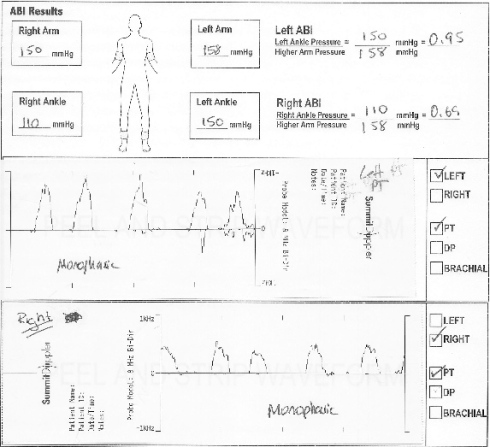The Ankle Brachial Index (ABI or ABPI) is the ratio of the blood pressure in the lower legs to the blood pressure in the arms. Compared to the arm, lower blood pressure in the leg is an indication of blocked arteries (peripheral vascular disease or PVD). The ABI is calculated by dividing the systolic blood pressure at the ankle by the systolic blood pressures in the arm.

risk factor for atherosclerosis:

Etiology:

Causes of Peripheral Vascular Disease:
1. Artheriosclerosis (also will develop in carotid or coronary artery, increase risk for stroke or heart attack)
Known first for pain in leg when exercising or walking(Intermittent claudication)
2. Diabetes Mellitus (There are FIVE pathway for pathogenesis of Macro and Microvascular diseases)
Treatment of PVD:
1. Cessation of smoking
2. Controlling high BP
3. Statins/Lipid level control
4. Dietary changes
5. Exercise
6. Diabetic control
7. Surgery
Pain of PVD can range from mild pain when exercise to severe pain even at rest. PVD limit the ability to exercise. Also can leads to sores and ulcers at leg that do not heal in critical limb ischemia that cause gangrene and require of amputation.
Stroke and heart attack are the most serious and common complication.
Over 5 years period, PVD sufferers
20% sustain stroke
30% fatal event
Critical Limb Ischaemia
30%- amputations
20%-dead
How to perform ABI test?
Things you need:
Doppler, Sphygmomanometer, Gel
Makes sure patient is warm and rest 10-15mins before begin
Measure all the 4 limbs SBP(posterior tibialis and brachial), take the highest reading
See here: http://www.youtube.com/watch?v=LvHeMiCaUdw
AHA ABI Interpretation:
Greater than 1.3, noncompressible arteries, obtain toe pressure
1.00-1.29, normal
0.91-0.99, appears normal, but exercise reveals low degree of obstruction
0.41-0.90, mild to moderate PAD (will experience intermittent claudication when they walk or exercise)
0.00-0.40, rest pain, failure for healing of injury to foot or toe
ABI provides 3 info:
1. Doppler sound
2. Index
3. Waveform
Normal young healthy have triphasic waveform
Biphasic: mildly abnormal
Monophasic progressive disease



People particularly at risk for PAD:
-->less than 50 years of age with DM and one other risk factor for atherosclerosis: HPT, Dyslipidemia, Smoking or Hyperhomocysteinemia
-->age 50-69, hx of diabetes or smoking
-->70 or older
-->leg symptoms upon exertion, intermittent claudication/ischemic rest pain
-->abnormal leg, ankle or foot pulse examination
-->known atherosclerotic carotid, coronary or renal artery disease
-->Psoriasis increase risk of PAD, MI or CVA
Not all people with PAD are symptomatic, only 10 percent have the classic symptoms of intermittent claudication
Adapted from:
Youtube; Vascular Hokanson Channel; How to do ABI
http://360woundcare.wordpress.com/category/uncategorized/
Netter Cardiology Images
No comments:
Post a Comment